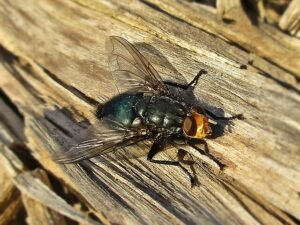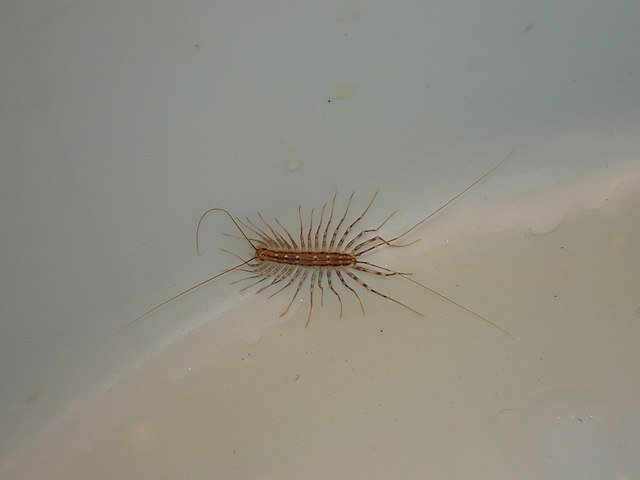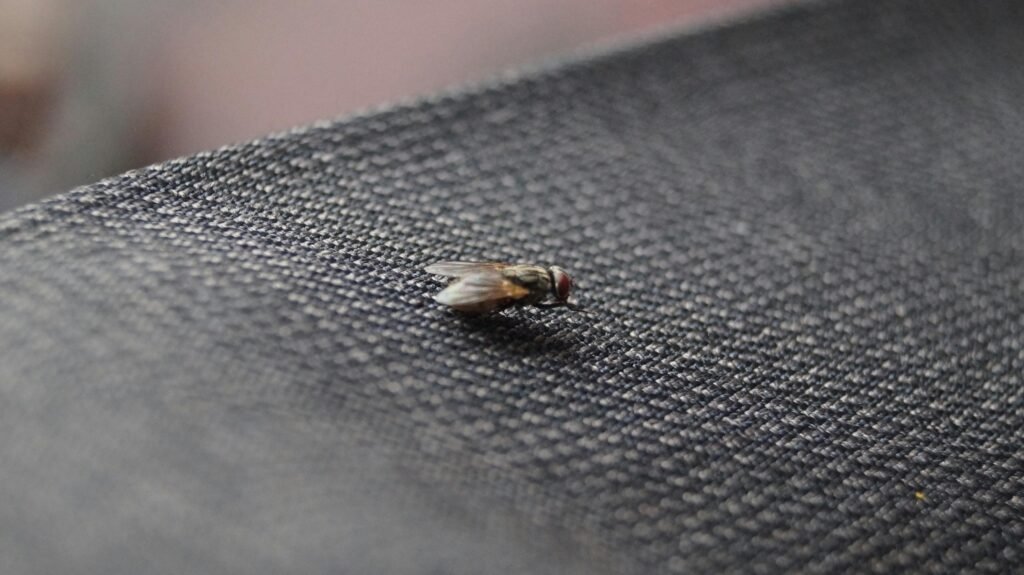Blow Flies (Calliphoridae): Identification, Biology, and Control
 Blow flies (Calliphoridae), sometimes called “bottle flies” due to their metallic sheen, are among the most conspicuous and medically significant flies encountered worldwide. Their shimmering bodies in shades of metallic green, blue, or bronze make them instantly recognizable, but behind that glossy appearance lies a group of insects closely linked to decomposition, sanitation problems, and public health concerns.
Blow flies (Calliphoridae), sometimes called “bottle flies” due to their metallic sheen, are among the most conspicuous and medically significant flies encountered worldwide. Their shimmering bodies in shades of metallic green, blue, or bronze make them instantly recognizable, but behind that glossy appearance lies a group of insects closely linked to decomposition, sanitation problems, and public health concerns.
They are not simply nuisances like Fruit Flies (Drosophila melanogaster), which hover over ripening bananas, or Cluster Flies (Pollenia rudis), which hide away in attics for the winter. Blow flies are strongly tied to carrion, animal waste, and organic decay, making their presence a warning sign of poor hygiene or hidden problems such as a dead rodent within the structure.
Yet blow flies are not entirely villains. In ecosystems, they serve as vital recyclers of nutrients, breaking down organic material and feeding scavengers. In forensic entomology, they are indispensable: investigators use their development stages to estimate postmortem intervals in criminal cases.
This duality—ecological importance versus household nuisance—makes blow flies a fascinating and critical subject for both science and pest control.
Identification
Size and Appearance
Adults measure 6–14 mm, making them larger than the common house fly.
Shiny metallic colors, especially blue, green, or bronze.
Big compound eyes, often reddish-brown.
Wings clear with well-defined veins.
Distinguishing Features
Louder, deeper buzz compared to house flies.
Fast fliers, attracted to light when indoors.
Found in large numbers when breeding material is present.
Key Difference from Similar Flies
Fruit Flies: much smaller, yellow-brown, linked to fermentation.
Cluster Flies: sluggish overwintering flies, not metallic.
Flesh Flies (Sarcophagidae): gray with stripes, larger maggots but less metallic adults.
Biology and Lifecycle
The blow fly life cycle is rapid and efficient, allowing infestations to explode if breeding material is available.
Egg Stage
Females lay eggs directly on carcasses, garbage, feces, or decaying food.
A single female may deposit hundreds of eggs at a time.
Larvae (Maggots)
Hatch within 8–24 hours depending on temperature.
Maggots feed intensely on decaying tissue.
This stage is so reliable in timing that forensic experts use larval age to calculate time of death.
Pupation
Mature larvae leave the food source and burrow into soil, crevices, or dry material.
They pupate for days to weeks, depending on climate.
Adult Emergence
Adults emerge, ready to mate within days.
Under warm conditions, the entire cycle can complete in as little as 7–10 days.
Behavior and Ecology
Blow flies are opportunistic and thrive in both natural and human environments.
Feeding: Adults feed on nectar, animal fluids, decaying tissue, and sometimes human food residues.
Reproduction: Attracted instantly to fresh carcasses—sometimes within minutes of death.
Habitat: Common in rural farms, urban trash sites, slaughterhouses, and meat-processing facilities.
Seasonality: Most abundant in warm months, but can persist year-round indoors.
Their behavior makes them highly visible and often alarming when they appear inside kitchens, healthcare facilities, or food-processing plants.
Public Health and Veterinary Significance
Blow flies pose risks far beyond annoyance:
Pathogen Transmission
Can carry E. coli, Salmonella, Shigella, and other dangerous bacteria.
Spread pathogens mechanically via their legs and body hairs.
Myiasis
Certain species lay eggs in open wounds of livestock, pets, or even humans.
The larvae feed on living or dead tissue, causing painful infestations.
Food Contamination
Landing on food after visiting carcasses or feces makes them potent vectors of foodborne illness.
Veterinary Losses
Livestock attacked by blow flies suffer weight loss, stress, and secondary infections.
Signs of Infestation
Metallic blue or green flies buzzing around windows.
Maggots found in trash bins, drains, pet waste, or carcasses of birds/rodents.
Sudden foul odors linked to organic decay.
High fly activity near outdoor garbage, compost piles, or animal pens.
Control and Prevention
Sanitation (Most Critical Step)
Prompt garbage removal and use of sealed containers.
Clean food spills and pet feeding areas.
Regular yard maintenance: remove pet waste quickly.
Locate and remove dead rodents or birds after pest control treatments.
Exclusion
Fine mesh screens on windows and vents.
Seal gaps around doors and roofs.
Maintain sanitation in garbage rooms and loading docks.
Trapping and Monitoring
UV light traps effective in kitchens and warehouses.
Sticky fly ribbons for small-scale monitoring.
Chemical and Professional Control
Residual insecticides around garbage rooms if sanitation is poor.
Aerosols for quick knockdown in kitchens.
IPM (Integrated Pest Management) to address root causes rather than just killing adults.
Forensic Applications
Perhaps the most fascinating (and disturbing) aspect of blow flies lies in forensic entomology. Because different species colonize remains in predictable sequences and their larval development is temperature-dependent, forensic experts can:
Estimate time of death (postmortem interval, PMI).
Determine if a body has been moved (by identifying species not native to the area where the body was found).
Detect wounds that existed before death (flies target open injuries first).
Species like Calliphora vicina and Lucilia sericata are particularly important in forensic cases across Europe and North America.
Veterinary and Agricultural Impact
Blow flies are notorious in livestock industries. In sheep farming, flystrike caused by species like Lucilia cuprina can lead to severe animal suffering and significant financial losses. Infestations can quickly spiral if untreated, as larvae burrow into wool and flesh.
Globally, blow flies are estimated to cause hundreds of millions of dollars annually in losses to sheep and cattle industries due to reduced weight gain, lower wool quality, and veterinary treatments. Control strategies include:
Regular inspection of livestock during fly season.
Mulesing (controversial practice of removing skin folds on sheep to reduce infestation sites).
Topical insecticides and repellents.
Breeding for flystrike-resistant animals in some regions.
This dimension sets blow flies apart from simple household pests like House Flies (Musca domestica) or Drain Flies (Psychodidae) — their economic footprint is massive.
FAQs
Q: Do blow flies bite humans?
A: No, they do not bite. They feed on liquids but never pierce skin.
Q: Why do blow flies come into houses?
A: They are attracted to decaying organic matter, including hidden carcasses (dead rodents in walls) or poorly managed trash.
Q: Are blow flies dangerous?
A: Yes, they can spread pathogens and, in some species, cause myiasis.
Q: How fast do they reproduce?
A: In warm weather, the entire life cycle can complete in just over a week.
Q: Are blow flies beneficial in any way?
A: Yes. They play a role in decomposition and are essential in forensic investigations. Some species (Lucilia sericata) are even used in maggot therapy to clean necrotic wounds.
Q: How do professionals control blow fly infestations?
A: Through Integrated Pest Management (IPM): sanitation, exclusion, targeted insecticides if necessary, and often carcass removal in wildlife/rodent-heavy environments.
Q: How long do blow flies live?
A: Adults usually live 2–4 weeks, but their life cycle from egg to adult can be completed in as little as 7–14 days in warm conditions.
Final Thoughts
The Blow Flies (Calliphoridae) are not just annoying buzzing insects; they are creatures of enormous ecological, forensic, and veterinary importance. While they are infamous for laying eggs on decaying organic matter and sometimes in living tissue (causing myiasis), they also serve as vital decomposers in ecosystems.
In forensic science, their precise developmental stages make them indispensable tools in estimating postmortem intervals. In agriculture and livestock, however, certain species like Lucilia sericata or Cochliomyia hominivorax inflict huge economic costs due to flystrike and infestations.
For homeowners, blow flies are usually a red flag — an indicator of hidden organic matter like dead rodents, spoiled meat, or improperly sealed garbage. Controlling them involves strict sanitation, exclusion, and in severe cases, professional pest management. Unlike nuisance flies such as Fruit Flies (Drosophila spp.) or Cluster Flies (Pollenia rudis), blow flies directly signal filth or decay and should never be ignored.
Disclaimer
This article is for informational purposes only. Pest control laws and approved chemicals vary by country. For best results and legal safety, we strongly recommend contacting a licensed pest control professional in your local area. Always make sure that the pest control technician is properly certified or licensed, depending on your country’s regulations. It’s important to confirm that they only use approved products and apply them exactly as instructed on the product label. In most places in Europe, UK, or USA, following label directions is not just best practice — it’s the law.
Author
Nasos Iliopoulos
MSc Agronomist & Certified Pest Control Expert
Scientific Director, Advance Services (Athens, Greece)
Licensed Pest Control Business – Ministry of Rural Development & Food (GR)
References
Wikipedia: Calliphoridae.
Penn State Extension – Blow Flies


